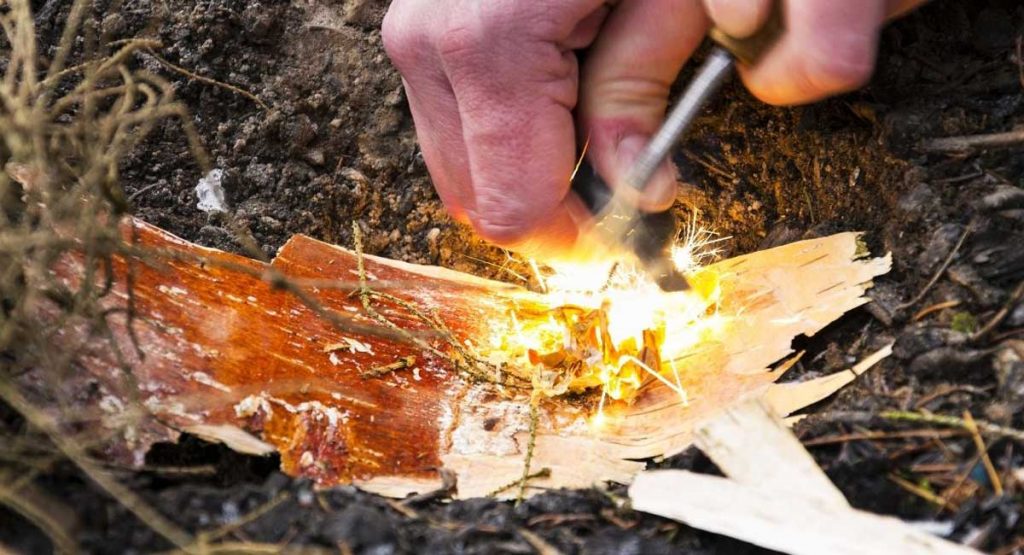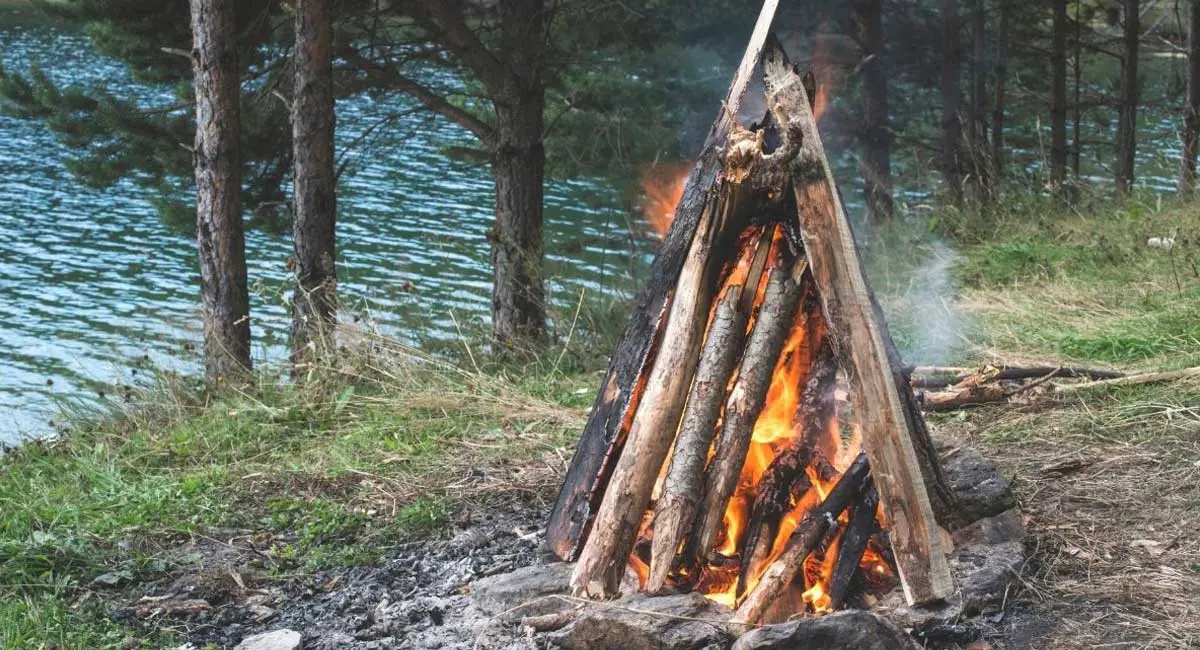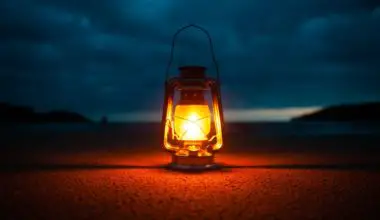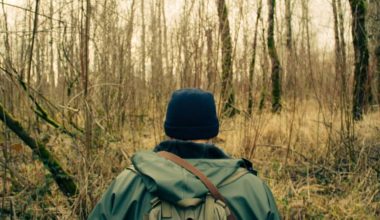Within modern day society, we have been afforded numerous tools at our disposal should we need to start a fire. But, if you’re about to embark on an outdoor adventure or find yourself in a survival situation, you certainly need to know how to start a fire in the wild.
This article will cover everything you need to know about starting fires safely and effectively if you happen to be away from civilization.
Table of Contents
Fire Starting Basics
If you want to learn how to start a fire, you need three things. You must have fuel, oxygen, and heat, otherwise known as the fire triangle. Once we combine these three things in sufficient amounts, we can start a chain reaction known as fire.
Fuel is what burns. Pretty much anything can burn, but, for our purposes, fuel will be wood, leaves, pine needles, or any other natural material we can find around our campsite. In an emergency, almost anything can be fuel, but be careful not to use fuel that releases toxic fumes into the air, such as plastics and other artificial materials.
Oxygen is the reactant and its gas triggers combustion. This explains why blowing on a fire makes it grow, you are adding more oxygen to the air around the fire. But, be careful not to blow too hard on the fire, otherwise you’ll create a temporary vacuum which will end up removing the oxygen and extinguishing the flame.
Heat is the final piece of the fire puzzle. While all materials have different ignition temperatures, paper ignites at around 450 degrees Fahrenheit. A forest is full of oxygen and fuel, but if you add a sufficient heat source, it can quickly turn into a forest fire.

How to Start a Fire in the Wild
Now, let’s go over the steps you need to follow in order to get a fire started safely and effectively.
1. Prepare the Fire Pit
The first step you need to take to start a fire in the wild is preparing the fire pit. If you don’t have an enclosed area to contain the fire, it can quickly grow out of control, which will not only endanger you, but anyone else around you.
To make a fire pit, dig a hole about a foot deep. The diameter of the hole will vary depending on how big you want to make your fire. If you’re making a fire to cook for one person, it only needs to be a few feet in diameter. If you’re trying to create a bonfire to signal help or scare off wildlife, the hole needs to be much bigger.
Next, surround the pit with rocks and clear any flammable debris within 10 feet of the pit, including any low-hanging branches above the pit. The point of this step is to make sure your fire stays where it belongs.
2. Gather Firewood
For fires in the wild, you can’t just throw a match on a log and expect to have a perfect campfire. In the wild, you have to gradually build up heat before you have yourself a blaze. This can be accomplished by starting with smaller pieces of wood and progressively adding larger pieces.
Firewood can be categorized into three types:
- Tinder is the smallest type, consisting of dry leaves, small sticks and twigs, wood shavings, pine needles, dry bark, and even paper if you happen to have some. Tinder is used to start the fire, so it has to be small enough to catch fire very quickly, and it has to be very dry.
- Kindling is medium-sized firewood, which consists of sticks less than an inch in diameter. This will be used to build the initial core of the fire.
- Fuel is large-sized firewood that can sustain the fire for long periods.
3. Prepare the Fire
Once your fire pit is built and you have collected your firewood, you can start to build the fire. It’s important to note that you can’t just drop a random collection of wood into a pit, toss in a match, and expect a beautiful blaze. You have to plan carefully in order to build a sustainable fire.
This is especially important if you’re in a survival scenario and your fire-starting implements are limited. You can’t afford to waste matches, so you have to be sure your fire catches and burns on your first try.
While there are numerous methods to prepare a fire, we’ll focus on the teepee method because it’s the simplest to explain. In the center of the fire pit, make a small pile of tinder. This will eventually be where you light the fire once it’s ready.
Next, arrange dry kindling around the tinder nest in a teepee shape. It can help to drive a single piece of kindling into the ground center to help other pieces lean against it in a circular fashion. Remember, be sure to leave a gap so you can access the tinder.
4. Light the Fire
If you have matches or a lighter handy, this is pretty simple. Just light a small piece of bark, paper, or pine needles, and use it to transfer flames to the tinder nest beneath the teepee you created. The tinder bundle will burn, which will then ignite the kindling.
At this point, you can gently blow on the burning tinder to add oxygen. Once the kindling is burning, you can add fuel. Be sure to start with smaller fuel first, then add progressively larger pieces as the fire gets bigger and hotter.
Then, arrange wet, green wood around the edge of the fire pit to help it dry out to be used later for fuel.
- CLASSIC UNIQUE WILDERNESS LIGHTER. AMAZE FRIENDS AND FAMILY. Perfect campout gadget for campfires, grilling, stoves, gas grills and barbecues. No match sticks, it’s forever matchless and relightable! Replace your matches box or case with this. Take it anywhere with you to camp, to BBQ, or for survival kits and emergency home preparedness sets. Sold in bulk, individually wrapped bundle, 2 per package.
- SMALL AND EASY TO CARRY. Mini portable size: 2.5 x 0.75 x 0.63 inches, weighs 1.3 oz. Tiny, put it in your pocket for EDC, personal every day carry. Lightweight, water proof, weatherproof, windproof, storm proof, infinite sparks in wind while wet or cold in all types of weather. The key chain is easy to throw on your key ring, lanyard, in your car or backpack with your gear for a day hike or backpacking.
- ULTIMATE HIGH QUALITY DURABLE CONSTRUCTION. The container housing is made from tough premium silver and gold solid stainless steel medal with a vintage faux leather wrap. Perma long honest endless striker life, will last 15,000 strikes. Magnesium steal alloy flint rod. Re usable and refillable canister. Liquid fuel is sold separately. Be sure to purchase Ronson or Ronsonol lighter fluid (light petroleum distillate). Includes cotton wicks and keyring.
- PERFECT STOCKING STUFFER GIFT for men and women, yourself and loved ones for the outdoors, adventurers, mountain hikers, military, camping, hiking, hunting, boating or travel. Old fashioned retro design. Prime tool for Boy Scouts, survivalists and outdoorsmen. Essential item for the camper or RV. Keep away from kids. Not a toy.
Alternative Fire Starters
If you don’t have matches or a lighter, you definitely made a mistake because these are some of the most fundamental survival items. If you ever find yourself in an emergency situation and you have time to grab two things, make sure you grab a cutting tool and something to start a fire with.
However, matches and lighters are both limited resources and could be rendered useless if they get wet. Next, we’ll look at how to start a fire with using alternative methods:
1. Flint & Steel
Flint & Steel is a great fire-starting tool, and some survivalists even argue it’s superior to matches. Basically, you have a piece of flint (a mineral) that sparks when you scrape it with a steel striker. It lasts forever and can even work when wet. As long as you have dry tinder, you can start a fire.
- 5ft Paracord included, gives you a good grip and never comes off. Comes with a bayite Striker-Pro striker attached to the paracord, always be prepared to start a fire
- bayite 6 Striking Edges Striker-Pro striker is made from TOOL GRADE HSS STEEL and has a distinct hardness, maximizes a shower of hot sparks, no matter whether you prefer to use your left hand or right hand to scrape. Don't use bad quality Knife as striker. Otherwise it will not produce enough sparks due to insufficient hardness of blade
- Ferrocerium Rod Length:4"(10cm). Diameter: 3/8"(10mm). Large enough for a shower of sparks and small enough to carry
- Made of high effective ferrocerium rod. Waterproof & Weatherproof, fits all weather, works in any weather condition
2. Magnifying Glass
A magnifying glass is another great fire-starting alternative. It works by simply magnifying the sun’s rays into a laser-like point, which easily reaches combustion temperatures. The problem, of course, is that this method only works in the daytime.
- These flexible, credit card-sized lenses magnify up to 4x and are perfect for wallet or pocket carry.
- Can be used for everyday magnification needs, like reading menus and newspapers.
- On a sunny day these fresnel lenses can be used as backup firestarters, saving you a match or a strike on your ferro rod.
- Protective Sleeve is printed with the Survival Mnemonic from US Military Field Manual FM 21-76-1.
3. Battery & Steel Wool
To start a fire with a battery and steel wool, hold the wool over some tinder, then touch the wool to both ends of the battery. This will cause an electrical current to flow through the wool, which will then ignite the tinder.
4. Friction Tools
If you find yourself in the wild with no tools, you’re in serious trouble. But, one option is to create a fire starter that generates heat through friction. This is the classic “rubbing two sticks together” method that you may have seen in movies or cartoons.
While there are several versions of friction fire starters, the one most likely to work in a pinch is the fire plow. In this design, you place a pile of tinder in the notch of a split piece of wood. After that, you can start to rub a stick in the V-shaped notch to generate heat. With enough friction, the tinder can ignite.
If you haven’t practiced this method before heading into the wilderness, your chances of success are very low. We recommend you to try this method out before your trip to see just how difficult it is. Trying it should then convince you how important flint & steel or matches are when you’re away from civilization.
- 🔥 [EASY-TO-USE BOW DRILL FIRE STARTER KIT] Keep drilling the fire board vertically until producing smoke by friction with the wrapped sting of the bamboo handle, then you can make the fire. Whoever can quickly get started, easily experience and master the primitive fire method.
- 🏅 [HIGH-QUALITY] Bow and handle are made of high-quality bamboo, the surface is smooth and does not hurt your hands.fire board uses high-quality paulownia wood and reserve 10 holes. The inner core of the rope uses 7 high-strength polyester cores with strong bearing capacity and good wear resistance.
- 🛠 [CONVENIENT] Thickened high-quality wood, matched with high-carbon steel bearings and ropes, the number of rotations can reach more than tens of thousands of times. We have already assembled the product, and it also comes with jute tinder, you can use it as soon as you receive it, no need to assemble it by yourself.
- 👦 It’s a good fire starter survival tool for scout or outdoor explorers to train and teach, and also a good outdoor educational tool, which can develop the patience, persistence, attentiveness, concentration, and outdoor emergency survival capability.
Safety Tips
If you’re going to start a fire in the wilderness, it’s important to observe some key safety tips. All it takes is one mistake to end up creating a forest fire that destroys land, houses, and, potentially, lives. Don’t let one careless mistake turn into a tragedy.
- If you’re in a designated campground, be sure campfires are allowed. Of course, if you’re in a survival scenario, this won’t be an issue.
- Keep your extra wood, kindling, and other flammable materials upwind and away from the fire pit. All it takes is one spark to create a situation you can’t control.
- Never leave your fire unattended. Fires are volatile and the situation can change quickly. Always be sure to have control of the situation.
- Be sure to keep water and a shovel nearby. If things get out of hand, these tools will be your best chance to regain control of the fire.
- To put the fire out, you need to cover it with water then stir the remains. You need to repeat this process until the fire pit is cool enough to touch, this helps ensure that the fire no longer poses a hazard.
Final Word
After reading this article you should have a better understanding of how to start a fire in the wild. If you remember to be prepared, plan carefully, and observe safety measures, you should have no trouble at all. This knowledge might even save your life one day.
We hope you found this article helpful. If you’re interested in additional content about preparedness and survival, please check out the other articles available on our site.






